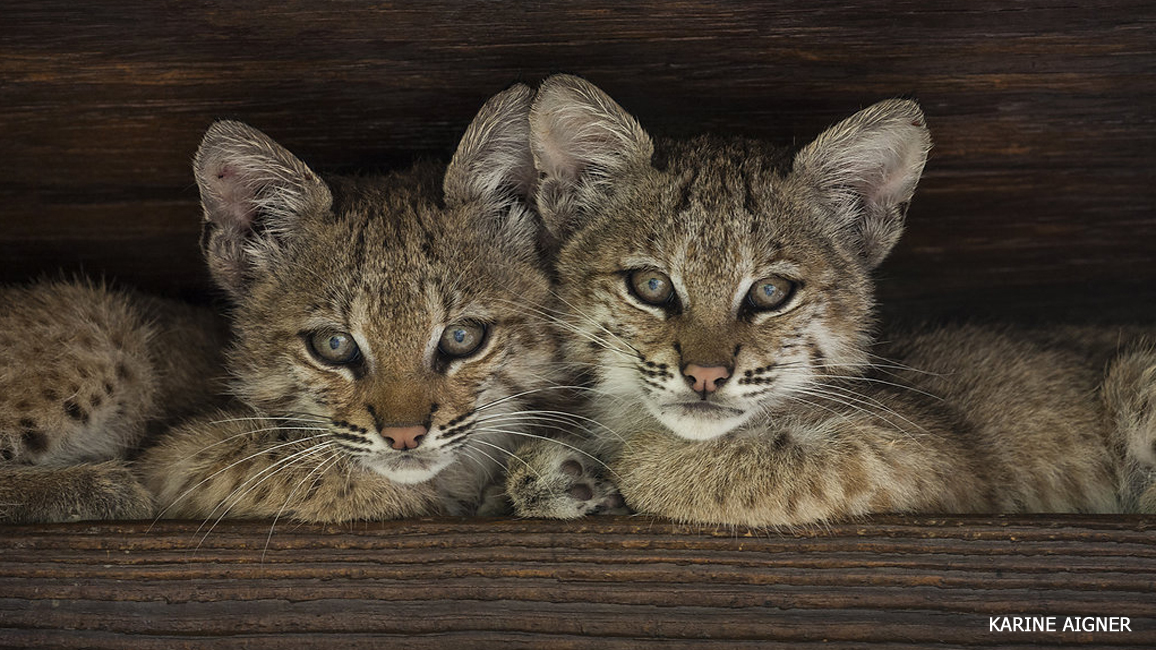
At Home with the Bobcats
By Hannah Schardt; photos by Karine Aigner
Wait! That rooftop cat in the shadows above isn’t a pet that slipped outside for a prowl. It’s a bobcat—the most common wild cat in North America.
Up high against the darkening sky, the bobcat may look like a house cat. But that’s because it’s just a baby. In less than a year, it’ll be twice the size of any pet cat you’ve ever seen!
Bobcats are found all across the United States and in parts of Canada and Mexico. They look a lot like their cousins, lynxes. But bobcats are smaller than lynxes, with smaller ear tufts and much smaller paws. Most of them spend their time in wild places such as forests and deserts and along creeks and rivers. There, they rest and care for babies in dens made from rocks or fallen trees.
But some bobcats live in places near people. The bobcat family in this story lives on a ranch in Texas. And the family den? It’s the space under the deck of a ranch house! Keep reading to see what life is like for these wild kittens and their hard-working mom.

Nice to Meet You!
Bobcats are pretty shy, and they rarely come out during the day. So while millions of people live within a few miles of a bobcat, most will never see one in the wild.
But one summer, photographer Karine Aigner got very lucky. While visiting the Texas ranch, she spotted a bobcat kitten as it raced across the patio. After the kitten disappeared, Karine draped a piece of cloth between two chairs, hid behind it with her camera, and waited.
It was a hot day, and at first the bobcats were nowhere in sight. But as the sun started to set, a mother bobcat appeared with three kittens!
Momcat—that’s what Karine called the mother cat—spotted the photographer at once. But she didn’t run away! In fact, she didn’t even seem nervous to be sharing the patio with a person. So Karine decided to spend the rest of the summer as the bobcat family photographer.
Busy Bobcats
Most people don’t want to do much in the Texas summer heat. These bobcats didn’t, either! They spent the hottest part of each day relaxing and snoozing under the house’s deck.
But once the sun went down and the air got cooler, the cats leaped into action. First, they climbed up onto the deck to sip water from a big bowl. Then, for the kittens, it was time to play!

Sometimes, Momcat stayed to play with the kittens—or to try to rest while they used her as a jungle gym. But usually she headed out into the scrubby desert to hunt for her favorite meal: small rodents called cotton rats!
While Momcat was away, the kittens wrestled and played. Sometimes they scrambled up nearby trees, then hung out for a while in the ranches. Sometimes they climbed right up onto the roof of the house. When they got tired, they curled up together in a sleepy heap to wait for Momcat to come back.
On the Hunt
When the kittens first started eating solid food, Momcat brought back dead cotton rats or other small prey for them. But as the kittens got older and bolder, Momcat arrived back home with still-living animals squirming in her jaws. Then she’d drop the wounded prey near the kittens.
The little bobcats practiced their hunting skills by stalking and pouncing on the animals. Then they fought each other for the right to eat what they’d “caught”!
Bye-Bye, Bobcats
Momcat took great care of her kittens. But not forever! Bobcats are solitary animals, which means they live mostly alone as adults. Eventually, it was time for the kittens to leave the ranch and find territories of their own.
A few months after she took the photos in this story, Karine visited the ranch. She didn’t expect to see the bobcats again. After all, Momcat’s work raising her kittens was done and the youngsters had moved on. But one evening, she spotted a bobcat trotting along near the house. Momcat was still around! Maybe she’d still be there the next summer—with a new batch of bobcat kittens!
Rangers: Remember to never feed bobcats. It’s better for wild animals when they don’t depend on people for food. —R.R.
















